A Crucial Test Flight For NASA And SpaceX
Early tomorrow morning, NASA and SpaceX will be testing a crucial part of America's return to manned space flight.
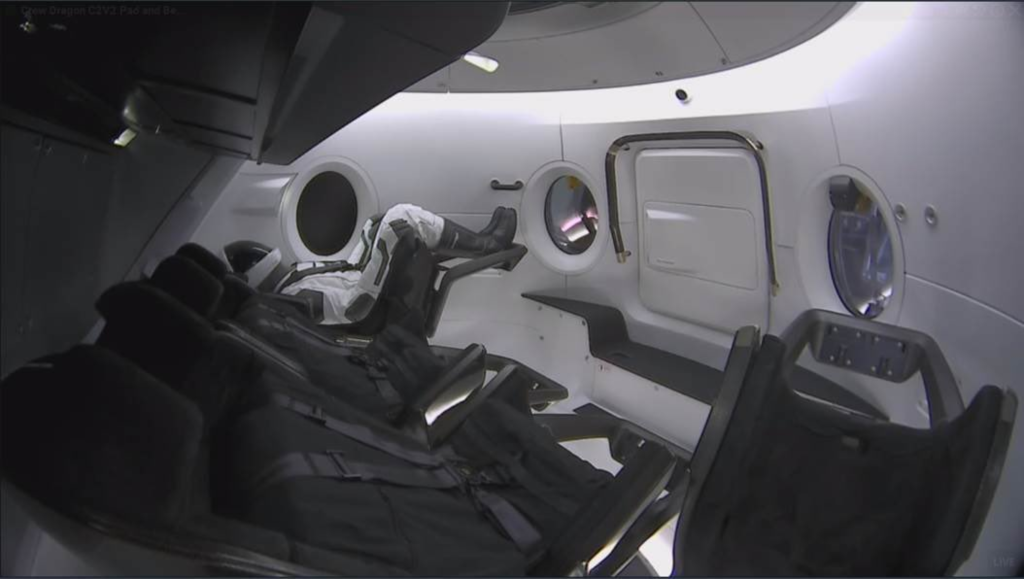
Early tomorrow morning, SpaceX and NASA will launch a test flight that will mark a new milestone in the effort to develop new ways to get American astronauts into orbit:
The space shuttle Atlantis rolled to a stop on a runway at NASA’s Kennedy Space Center in Florida on July 21, 2011, its last flight. That ended an era of American spacecraft carrying astronauts to space.
“Mission complete, Houston,” said Christopher J. Ferguson, the mission commander. “After serving the world for over 30 years, the space shuttle has earned its place in history, and it’s come to a final stop.”
Nearly eight years later, a replacement for the space shuttles is finally on the launchpad, not far from where Atlantis landed. During that time, NASA astronauts have flown to the International Space Station aboard Russian Soyuz spacecraft.
Reflecting a new reliance on the private sector, NASA hired two companies, SpaceX and Boeing, to design and build transportation for its astronauts.
After years of delays, the first of those systems — SpaceX’s Crew Dragon capsule — is scheduled for liftoff on Saturday at 2:49 a.m. Eastern Standard Time on top of one of the company’s Falcon 9 rockets. Forecasts call for an 80 percent chance of favorable weather.
“This is an invaluable exercise for us to learn in the space environment how these systems will be working,” said Kathryn Lueders, the manager of NASA’s Commercial Crew program, during a news conference on Thursday.
The capsule is not yet ready for astronauts, but the flight is intended as an end-to-end test, doing everything that one with astronauts would do, including docking with the International Space Station early Sunday morning. Then on March 8, it is to leave the space station, and parachute into the Atlantic Ocean a few hours later.
During a previous news conference last week, William H. Gerstenmaier, the NASA official who oversees the human spaceflight program, said problems were to be expected.
“I guarantee everything will not work exactly right, and that’s cool,” Mr. Gerstenmaier said. “That’s exactly what we want to do. We want to maximize our learning so we can get this stuff ready so when we put crew on, we’re ready to go do a real crew mission, and it’ll be the right safety for our crews.”
A subsequent flight with people aboard could come later this year. Boeing’s first test flight for its capsule, named Starliner, could be launched as soon as next month.
The Crew Dragon is an upgraded, sleeker version of the SpaceX Dragon capsule that has been taking cargo to the space station since 2012.
Crew Dragon’s powerful thrusters serve as part of the escape system to power astronauts to safety in case of a problem with the rocket. It also has the ability to autonomously dock with the space station, instead of relying on an astronaut aboard the station to grab and guide the capsule with the station’s robotic arm.
The SpaceX capsule also includes up to seven seats and consoles displaying information for the astronauts. For this flight, one of the seats will be occupied with a sort of artificial person — what NASA calls an A.T.D. or “anthropomorphic test device” — which will be wearing a SpaceX spacesuit. The device includes sensors to measure forces and accelerations that a person would experience on the trip.
The SpaceX engineers named it Ripley, after the heroine in the Alien movies played by Sigourney Weaver.
Similar to how SpaceX broadcast video of a spacesuit-clad “Starman” in a Tesla roadster launched by its Falcon Heavy rocket last year, there will be cameras inside the Crew Dragon capsule. “It will give you a perspective that you would have if you were inside,” said Hans Koenigsmann, SpaceX’s vice president for build and flight reliability.
SpaceX has faced scrutiny for decisions like planning for the crew to be onboard while the rocket is fueled. In the past, NASA has considered that too risky, but SpaceX prefers to use supercooled liquid oxygen and kerosene, which are more efficient but cannot remain at those temperatures for very long. Fueling begins just 35 minutes before liftoff.
The space agency has tentatively approved SpaceX’s approach, known as “load and go.” “We came to the conclusion that this was an acceptable risk that we were willing to take,” said Patrick G. Forrester, chief of NASA’s astronaut office.
Other issues still to be resolved before a crewed flight include certification of the parachutes and fixing a design issue with the thrusters where pieces can break off if they get too cold.
As The Washington Post notes, this test launch represents a crucial first step for both NASA and SpaceX:
KENNEDY SPACE CENTER, Fla. — The Securities and Exchange Commission is all over him. The Air Force inspector general is auditing his launch certifications. And even NASA, one of his most ardent supporters, is reviewing the safety culture at SpaceX after Elon Musk smoked a joint on a podcast.
If that weren’t enough pressure, the billionaire entrepreneur is facing one of the most crucial moments in SpaceX’s history early Saturday, when the spacecraft designed to carry humans is scheduled to lift off from a storied launch site here.
Although the Dragon spacecraft won’t be carrying astronauts — only a mannequin named “Ripley” with sensors and about 400 pounds of cargo — the flight will mark a significant step toward the restoration of human spaceflight from U.S. soil since the space shuttle was retired nearly eight years ago.
The heat isn’t just on SpaceX and Musk, who has drawn scrutiny from the SEC over his leadership of his electric car company, Tesla, but on NASA, as well. Years ago, it placed a bold bet on the private sector and outsourced human spaceflight to the International Space Station to two companies: SpaceX and Boeing. The companies won the contracts, worth a combined $6.8 billion, in 2014.
Since then, both companies have faced setbacks and delays as they struggled to meet NASA’s rigorous safety requirements. But now NASA says they are poised at long last to make their first flights with humans this year — a timeline many in the industry believe may be optimistic given the immense challenge.
Since the space shuttle retired in 2011, NASA has had to purchase seats on a Russia spacecraft, the Soyuz. Those seats runs out by the end of this year, so if SpaceX and Boeing’s spacecraft are not ready, NASA would have to purchase additional seats or face the prospect of not having an American astronaut on board the space station, in which the United States has invested about $100 billion.
With so much at stake, SpaceX’s launch, scheduled for 2:49 a.m. Saturday, “is an absolutely critical first step,” William Gerstenmaier, NASA’s associate administrator for Human Exploration and Operations, said during a news briefing last week.
For SpaceX, a successful flight would mark a crucial next step in its quest to make routine human spaceflight possible. And it would be another triumph for a company that improbably upended the launch industry by pulling off such feats as landing and reusing rocket boosters, usually discarded after each use.
A failure, however, would be devastating. Two SpaceX rockets have exploded: one in 2015 while flying cargo to the space station and another on the launchpad in 2016 ahead of an engine test fire. The company has bounced back from those failures and flown nearly 70 successful missions. But recently the Air Force inspector general announced it is reviewing the certifications granted to SpaceX that allow the company to fly national security missions, a key source of revenue.
NASA officials said that although they are confident about the flight, and have signed off on it after multiple flight reviews, SpaceX must still address several technical issues before flying people later this year.
SpaceX also said it is ready. The company has done “an incredible amount of testing to make sure that everything is safe and ready to go,” Hans Koenigsmann, SpaceX’s vice president for build and flight reliability, told reporters Thursday.
It’s worth noting that this project is designed primarily to develop a means for the United States to deliver astronauts to the International Space Station (ISS) and, if necessary, evacuate them in the event of an emergency without having to rely on the Russians and their Soyuz space capsules, which are based on the same technology that was around in the 1970s. Other projects, under more direct NASA control, are aimed at launch systems and crew vehicles for projects such as a return trip to the Moon sometime in the 2020s and, eventually, a mission to Mars that is likely not going to be feasible until the 2030s at the earliest. For SpaceX and Boeing, successful development of a commercial manned program would be a significant boost for their business model, especially for SpaceX, which has, but for a few setbacks, developed a successful and reliable launch capability that has been used to send supplies to the ISS as well as putting commercial and military satellites into orbit.
s I’ve noted before the success of companies such as SpaceX and Blue Origin are evidence in favor of the argument that many people made in the wake of the end of the Space Shuttle program, namely that the nation was abandoning space exploration and placing its future in the hands of Russia and other nations. Instead what we have seen in the intervening years is something quite to the contrary. While SpaceX and its fellow private companies have concentrated their efforts on development of launch vehicles, NASA continues to pursue its own heavy launch vehicle that will send men back to the Moon and beyond, and the unmanned probes it has launched such and New Horizon, Juno, and Cassini, have sent back thrilling pictures and groundbreaking information regarding Pluto, Jupiter, and Saturn. Additionally, space telescopes such as Hubble and Kepler have provided us with new insights regarding the origins of the universe and the existence of Earth-like planets outside the Solar System. Rather than an abandonment of space, the last seven years have shown that both privately and publicly, the United States is still going strong in the space race and will be for a long time to come.
Unless it gets scrubbed due to weather conditions or for other reasons, tomorrow’s test flight launch will take place while most of us are asleep, at just before 3:00 a.m. on the East Coast and near midnight on the West Coast. If you’re so inclined, though, you can watch via SpaceX’s webcast.
Photo of interior of SpaceX Crew Dragon via Elon Musk’s Twitter feed.

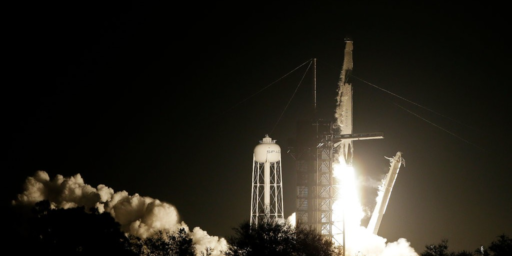
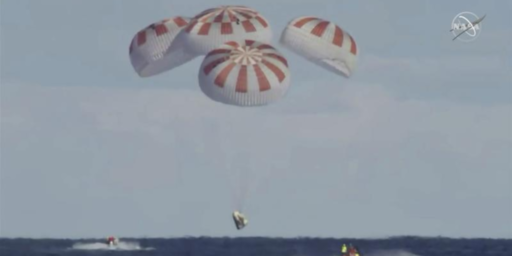
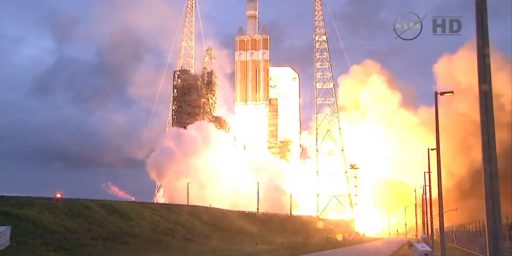
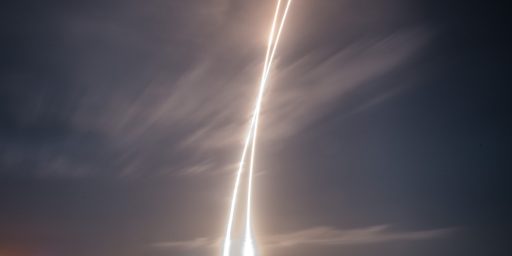
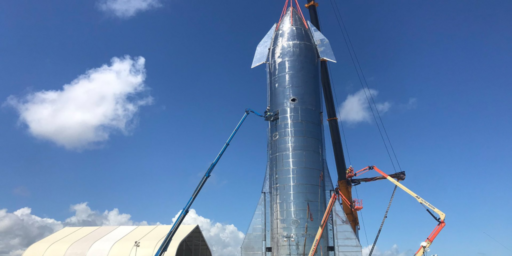
I thought any risky launch with a dummy must have Buster 🙂
This is all amazing and very, very interesting, but I’ll find out how the launch went, if it went, when I wake up in the morning. I’m past the stage of staying up late, or getting up way too early, to see one live.
The Shuttle, BTW, was never designed to be what it was. The early plans were for a wide arrange of launch systems, space stations, lunar ships, lunar bases, etc. This was whittled down until only the Shuttle remained. Even then, it suffered modifications to fit with military needs.
Three are things bets left to the government, but designing and running a transportation system isn’t one of them, not a wide ranging one. Government has a role, as it does in aviation.
This fills me with pride as an American and even just as a human. I was fortunate to be raised in what I think of the Kennedy era, when we believed we could do immense and amazing things and solve the seemingly unsolvable. I feel bad for those raised in what I think of as the Reagan era, in which the dominant theme is that “We” can’t, that we should give up on big projects and solving big problems. Space X and Blue Origin actually represents the best of both eras. A commitment to steady funding by government while simultaneously refusing to pick the winners led to a private company that can blast a man into space. There’s a little bit of Heinlein’s “The Man Who Sold the Moon” in this story, in a good way.
@Kathy:
I volunteered for the role of “crew simulant”, but they turned me down.
I feel like there should be more obvious internal latches on the hatch, because can imagine just sitting there in the middle seat, staring at that little door which is the only thing between me and the endless void of space and thinking “how do I know they locked it properly before launch?”
@Kathy:
All mass transit, and the interstate highway system, disagree with you.
If North Korea had a space program at this level of sophistication, we would invade.
Now, I trust our billionaires a little more than the murderous thug ruling North Korea, but I’m not sure we should celebrate the increased proliferation of mixed use technologies.
When we finally have our ubiquitous flying cars, terrorists will have their cruise missiles.
@DrDaveT:
I believe that is called a “fluffer”
@MarkedMan:
I think that story is the prequel to “Requiem,” which is one of the saddest stories I’ve ever read.
@Stormy Dragon:
Well, if you hear air escaping, feel your flesh freezing and your eyes boiling, then there’s very likely a major leak.
55 years after watching Mercury-Redstone and Gemini-Titan I’m still somewhat excited to watch little rockets blast a few men in little capsules into low earth orbit.
Earth to Mars in ten weeks! NASA’s new thruster engine!
Also, ion engine is tested successfully.
https://www.sciencealert.com/nasa-has-trialled-an-engine-that-would-take-us-to-Mars-in-10-weeks#
https://www.nasa.gov/centers/glenn/about/fs21grc.html
We’re looking at 4C warming by the end of the century, but you liberal jug-heads keep focusing on irrelevant toys for billionaires. I’m sure they’ll give you a ride to their Mars utopia so you can conduct contract law in the dome and tell them how proud you are they boiled a planet.
@Ben Wolf: Not irrelevant, but here, now. The American people need to see a challenge like the mission to the moon. Under the Mercury, Gemini, and Apollo space programs, this country was united. Science and technology was in the front seat.
Now, to the moon in thirty minutes: NASA X3 Ion Thruster engine – watch this and your pulse rate will quicken:
https://www.youtube.com/watch?v=CiWb44VRZGo
We don’t take a back seat to nobody. USA #1
I happened to be up at 2 40 a.m. this morning, so I watched the launch. It was pretty cool, especially the first stage landing on the robot barge 500 km away like 10 minutes later.
@Teve:
Those landings are amazing.
If you watch video of the launch, you’ll notice speed and altitude indicators on the lower left. You can see how fast the first stage is going, and how high it is. Then it comes down, uses some controlled burns to steer itself, and lands softly on a very small target.
One launch had video of the stage descending, from a camera attached to the rocket.
@Kathy: they’ve now successfully landed the first stage 35 times. I think they’re getting pretty good at that.
@Teve:
Objectively, yes.
By a certain Troll’s standards, they’ve failed a few times, and some launches don’t permit enough leftover fuel for recovery, so they’re a dismal failure that’s worse then if they launched empty rockets directly into the trash bin.
It won’t be easy but then neither was flying to the moon.